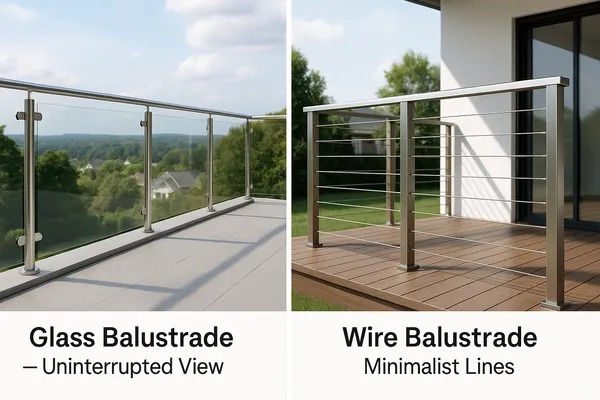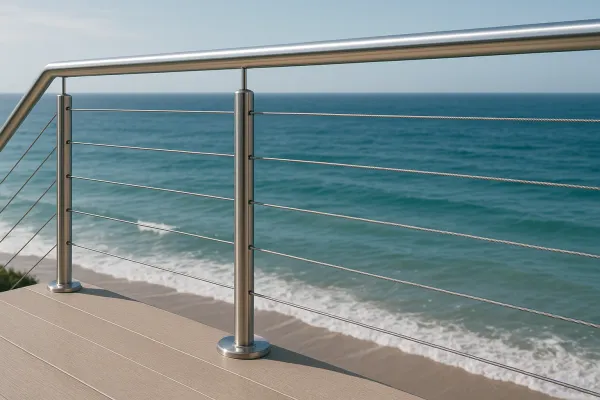You want a beautiful, safe railing that stays clean and strong. But you’ve seen rust on metal before and worry it could happen on a stainless steel balcony or stair. Here’s the plain, tested way to prevent rust and keep a stainless steel railing looking new for years.
Yes, you can sometimes see rust on stainless railings, but it’s usually light surface rust caused by salt, grime, or scratches sitting on the stainless steel surface. With the right alloy, smart design, and regular cleaning, a stainless steel railing system is highly resistant to corrosion and stays bright without rusting.

As a professional stainless steel manufacturer and exporter based in China, we’ve supplied thousands of railing posts, tubes, and fittings for residential and commercial properties. Below is a field-tested guide you can share with specifiers, installers, and owners.
Stainless steel contains chromium. When oxygen hits it, chromium forms a thin, invisible protective layer on the surface of stainless steel. That layer is what makes stainless steel so resistant to corrosion. If this film is damaged by a deep scratch or harsh grit and not cleaned, tiny rust stains can appear.
In daily life, most stainless steel rails show great durability because the passive film repairs itself when you remove dirt and moisture. Choose the right grade, keep the finish even, and avoid design traps that hold water. Do that, and the benefits of stainless steel are obvious: clean lines, low maintenance, and long service life.
They can show tea-colored marks or rust spots if you ignore washing in windy, salty air. Saltwater spray leaves deposits that hold moisture against metal. That’s why a deck railing at the coast needs the right grade and a simple wash schedule, especially in coastal areas.
Inland settings are easier, but high humidity and pollution can still leave a film on posts and clamps. Pick the right railing materials, then plan regular cleaning to keep surfaces bright. For balcony projects, see our guide to stainless steel railings for balcony for finish and detailing ideas.
304 stainless steel works well indoors and away from salt or de-icing chemicals. In coastal areas or pool decks, 316 (with molybdenum) boosts corrosion resistance. Match the grade to the climate, then keep it clean. A brushed polished stainless finish hides fingerprints and is easy to wipe.
For stairs and landings, we often pair 316 posts with 304 rails to balance cost and risk. Explore options in our stainless stair railing range—satin, mirror, and custom finishes available for indoor and outdoor projects.
Quick spec table
| Environment | Recommended Grade | Finish | Notes |
|---|---|---|---|
| Dry interior | 304 | Satin brush | Minimal wash schedule |
| City exterior | 304 or 316 | Satin or bead | Rinse grime seasonally |
| Seaside or pool | 316 | Satin or mirror | Rinse after storms; avoid deposits |
| Industrial spray | 316 | Satin | Add shields; inspect hardware |
Three everyday triggers create stain or light surface rust:
None of these mean the stainless steel failed. They mean the film was blocked or damaged. Remove the dirt, let air reach the metal, and the passive layer rebuilds. That’s why we emphasize simple washdowns on our stainless steel handrail jobs.
Infill doesn’t change base metallurgy, but it changes maintenance. Glass shows spots; cables trap less water. A single, well-designed cable railing drains fast and is easy to rinse. For long runs, modern cable railing systems pair 316 cables with 316 hardware for best weathering.
If you specify cable, keep terminations off the splash zone and seal fastener penetrations. If you prefer glass, specify uniform edges, weeps, and easy access for cleaning. For stairs, see stainless steel tube handrail that pairs neatly with either infill.

Railing maintenance is light work if you plan it. Rinse after storms. Wipe spill lines and bird droppings when you see them. Once or twice a season, clean the rails with a mild detergent and a soft cloth. That’s it for most sites.
Watch early signs of rust like faint tea stains around joints. Treat early, and you protect joins and anchors. Consistent habits keep the finish even and give you long, calm years of service.
Use a non-chloride cleaner or a dedicated stainless steel cleaner. Avoid abrasive cleaners and never scrub with steel wool; they can leave particles that later stain. If you must spot-treat, pick a labeled rust remover, rinse heavily, and dry. Always test a small area first.
Skip harsh chemicals like bleach. A gentle rinse, a simple soap, and a soft wipe protect the finish. That routine will keep your stainless steel looking bright, uniform, and calm.
Smart railing installation prevents trapped moisture. Slope caps so water sheds. Vent hollow sections. Seal dissimilar metal contacts. If the design calls for color, quality powder coating on stainless is a tough skin and can complement modern façades.
Anchor choices matter. Choose proven washers and gaskets, and place fixings where runoff doesn’t pool. Strong, well-sealed railing posts reduce maintenance on windy corners. Browse our component kits and stainless steel railing parts for tested details and matching hardware.
The benefits of stainless steel railings are simple: better baseline weathering, less repainting, and a steady finish. A railing system in 316 is resistant to rust in tough climates and stays consistent across seasons.
Compared to other steel products, stainless offers solid corrosion control and smooth upkeep. That steadiness gives owners peace of mind and predictable costs. For whole-building packages, see our stainless steel railing solutions for stairs, balconies, and terraces.
A coastal hotel needed to install stainless steel rails that would stand up to spray and sun. We recommended 316 posts, sealed base plates, and satin finishes. After installing stainless steel railings, the team adopted a simple rinse plan after storms. One year later, the runs were clean and even.
Here’s what worked: limit crevices, specify 316 fasteners, and keep glass away from heavy spray lines. For open views, we also designed a cable section on the leeward side. The result: bright lines, open sight, and less cleaning time.

| Item | Best Practice | Why it helps |
|---|---|---|
| Grade | 304 interior; 316 marine | Matches risk profile |
| Finish | Satin brush | Hides prints; easy to wipe |
| Joints | Seal and vent | Stops water traps |
| Cleaning | Rinse + mild soap | Maintains passive film |
| Upgrades | Mirror edges at entrances | Adds pop; easy to maintain |
| Extras | Drain holes at caps | Reduces streaking |
Pro tip: For outdoor use, specify smooth top rails and uniform grain direction. That small step makes washing faster and more even.
If you spot light surface rust, wash first. If marks remain, use a labeled rust remover, rinse well, and dry. Deep scratch lines? Feather with non-metal pads, clean, and allow air to restore the passive film.
Note that stainless steel can become marked by de-icing salts or pool splash. Rinse those areas after heavy use. Good habits and quick fixes keep a long-lasting, even finish.
When in doubt, consult our tech sheets and choose components from our stainless stair railing and stainless steel handrail families to match grade and finish.
Do stainless steel railings rust outdoors?
They resist it very well. With the right grade and cleaning, they’re resistant to corrosion and stay bright. Deposits cause most marks; remove them and the passive film heals.
Can I use bleach or strong acids on my rails?
Avoid harsh chemicals. They can pit metal and leave residue that later stain. Use mild soap and water, then dry.
What if I already see brown marks?
Treat quickly. Start with soap and water, then a labeled rust remover if needed. Rinse and dry the area. Keep an eye on joints.
Is stainless good for seaside balconies?
Yes—pick 316 grade, design for drainage, and rinse after storms. With that plan, rails stay even and calm in spray and saltwater.
Which finish is easiest to maintain?
Satin brush is forgiving and hides handling marks. Mirror looks premium but shows prints. Match finish to traffic and cleaning habits.
| Location | Recommended Grade | Corrosion Risk | Notes |
|---|---|---|---|
| Indoor (dry) | 304 | Low | Soap wash, minimal care |
| City outdoor | 304 or 316 | Medium | Rinse after rain, check joints |
| Seaside/Pool | 316 | High | Rinse after storms, avoid salt deposits |
What Is Polished Stainless Steel? How to Polish Stainless Steel and Compare Brushed Finishes
Balcony Railing Stainless Steel – Types, Prices, and How to Choose the Right System
What Are the Grades of Stainless Steel Railings?
Iron Railing vs Steel Railing: Which Is Better for Your Home and Projects?